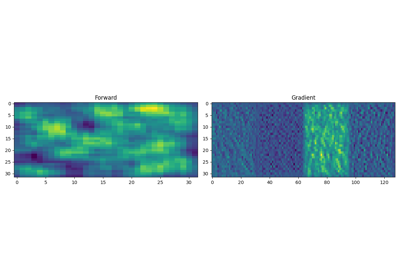pylops.TorchOperator¶
- class pylops.TorchOperator(*args, **kwargs)[source]¶
Wrap a PyLops operator into a Torch function.
This class can be used to wrap a pylops operator into a torch function. Doing so, users can mix native torch functions (e.g. basic linear algebra operations, neural networks, etc.) and pylops operators.
Since all operators in PyLops are linear operators, a Torch function is simply implemented by using the forward operator for its forward pass and the adjoint operator for its backward (gradient) pass.
- Parameters
- Op
pylops.LinearOperator PyLops operator
- batch
bool, optional Input has single sample (
False) or batch of samples (True). Ifbatch==Falsethe input must be a 1-d Torch tensor, if batch==False` the input must be a 2-d Torch tensor with batches along the first dimension- device
str, optional Device to be used when applying operator (
cpuorgpu)- devicetorch
str, optional Device to be assigned the output of the operator to (any Torch-compatible device)
- Op
Methods
__init__(Op[, batch, device, devicetorch])Initialize this LinearOperator.
adjoint()Hermitian adjoint.
apply(x)Apply forward pass to input vector
apply_columns(cols)Apply subset of columns of operator
cond([uselobpcg])Condition number of linear operator.
conj()Complex conjugate operator
div(y[, niter, densesolver])Solve the linear problem \(\mathbf{y}=\mathbf{A}\mathbf{x}\).
dot(x)Matrix-matrix or matrix-vector multiplication.
eigs([neigs, symmetric, niter, uselobpcg])Most significant eigenvalues of linear operator.
matmat(X)Matrix-matrix multiplication.
matvec(x)Matrix-vector multiplication.
reset_count()Reset counters
rmatmat(X)Matrix-matrix multiplication.
rmatvec(x)Adjoint matrix-vector multiplication.
todense([backend])Return dense matrix.
toimag([forw, adj])Imag operator
toreal([forw, adj])Real operator
tosparse()Return sparse matrix.
trace([neval, method, backend])Trace of linear operator.
transpose()Transpose this linear operator.
